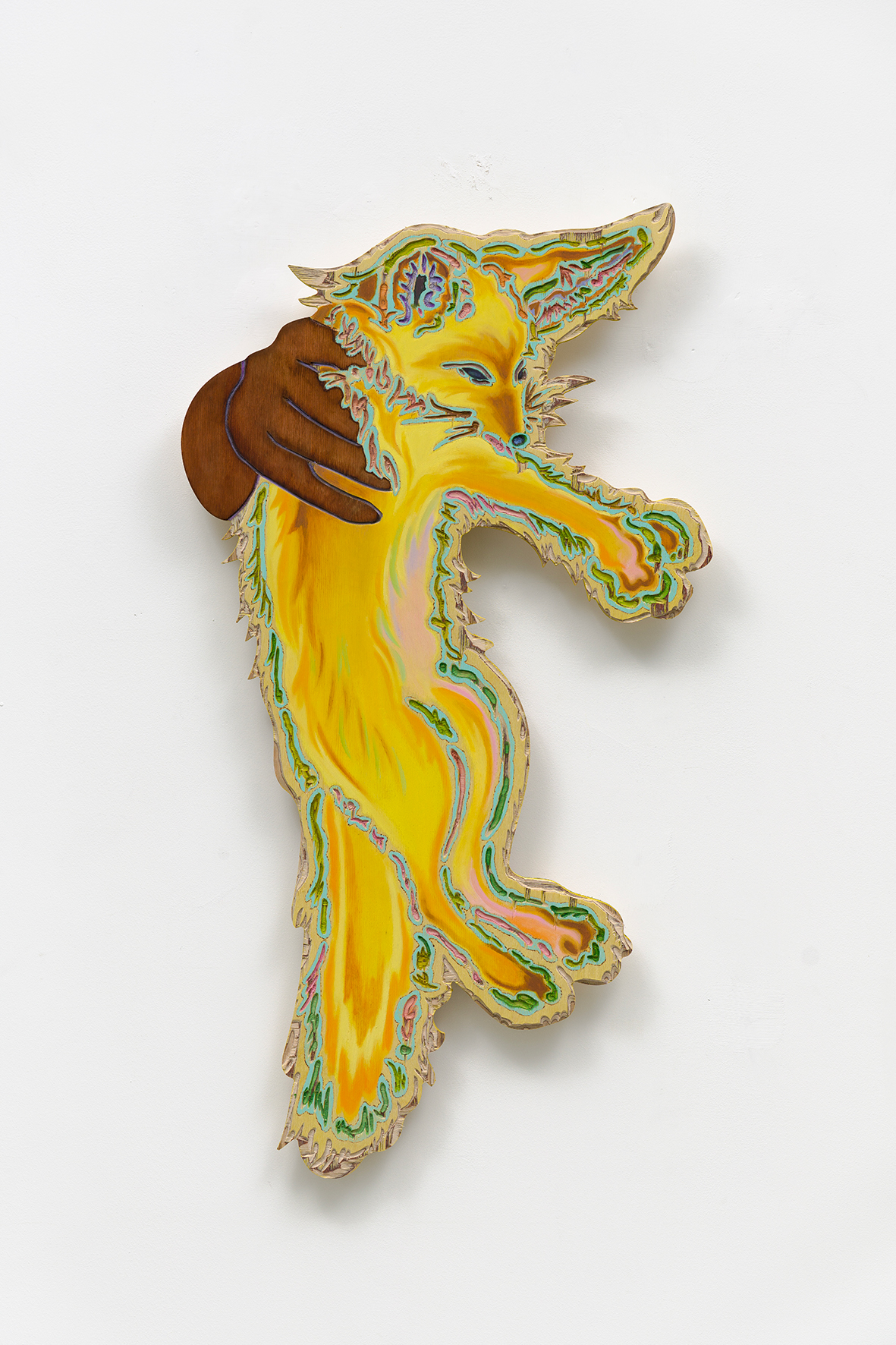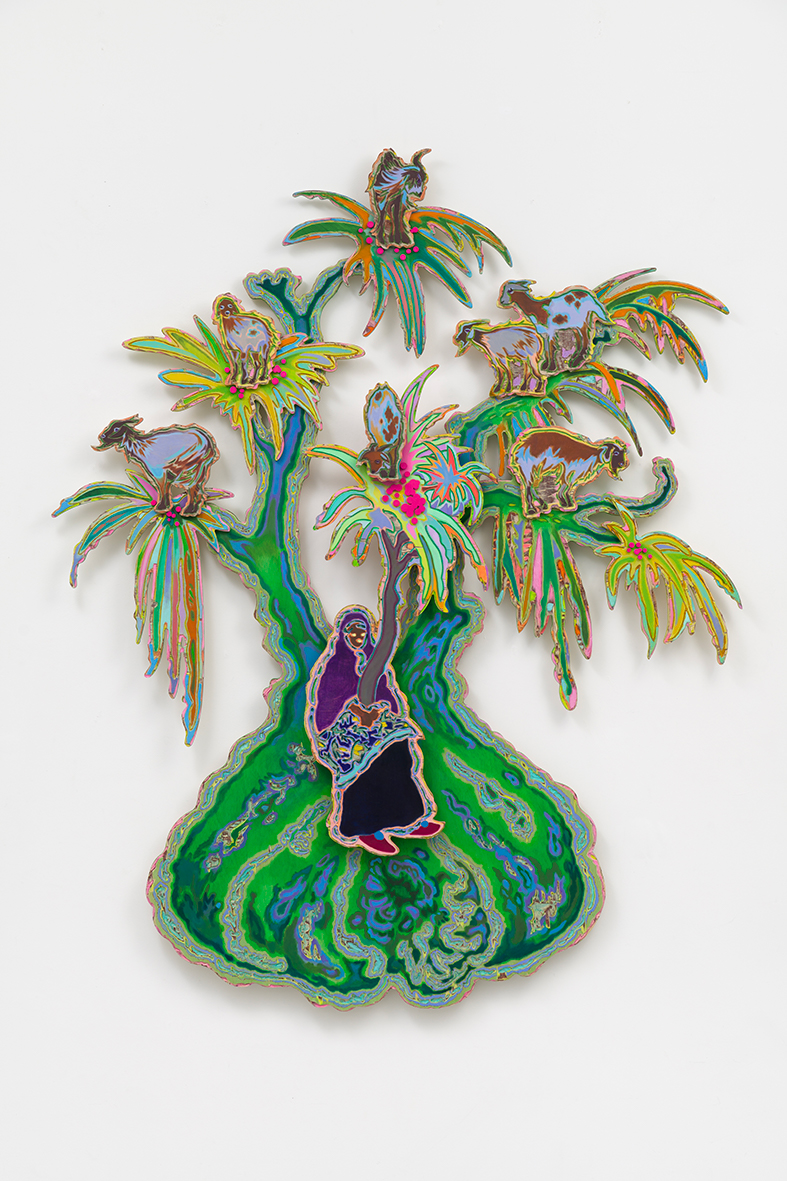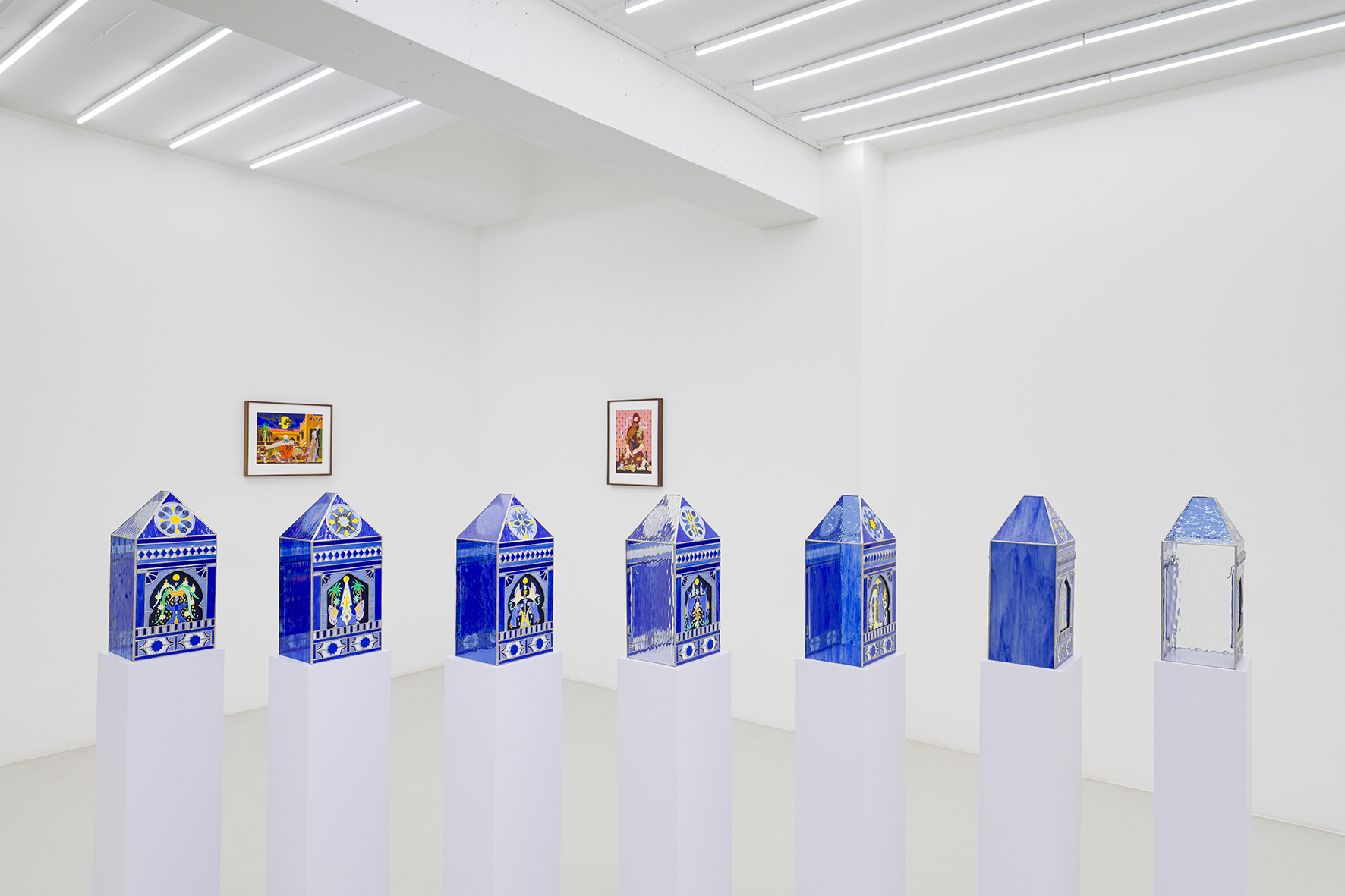Exhibition
Everything Returns to Desert
모든 것은 사막으로 돌아간다

INSTALLATION VIEW “Everything Returns to Desert“, 2025. Courtesy of the Artist and ThisWeekendRoom.
Walking across the sands of the Sahara Desert, I came upon the bodies of two camels lying opposite each other like fortresses. Looking at them, he said they had probably fought to death. Under the blazing sun, I gazed at the bones, bleached white and glistening in the sand, and picked up a fragment, telling him I wished to keep it. He looked slightly uneasy, but allowed me to take it. Back at the lodge, holding the bone, I reflected on the strange tension between the fear of witnessing death and the desire to possess a beautiful form. Then it struck me, perhaps I had violated some implicit order. After much hesitation, I returned the bone to him the next day. Smiling, he said, “A good decision. I’ll return this bone to its place. Everything is born of the desert and returns to the desert.”
– from the artist note
Memory is at once selective and beyond our control. It settles deep beneath consciousness, surfacing without warning, indifferent to intention. In fact, memory is nothing more than a partial collection of responses to countless stimuli. Yet when these fleeting waves break through once more, they are reshaped by the subject’s thought and perception, emerging into language or form that renders them tangible.
Shinyoung Park reconstructs the sociocultural characteristics of unfamiliar environments encountered while traveling across different regions into subjective records. Her work often explores the boundaries between humans and animals, civilization and nature, reality and imagination—inviting viewers to reconsider events unfolding beyond the spatiotemporal positions they inhabit. Fragments collected from various places are recorded through printmaking, drawing, and sculptural works using materials such as paper, wood, and stained glass. This exhibition draws on the artist’s past journey to Morocco, examining the lingering residues of memories and emotions she had long been unable to process. The traces filtered through this process of digestion are visualized according to her own formal principles, revealing how they operate in her present and future experience beyond mere recollection.
Morocco, with its vast geography spanning the Sahara Desert, the Atlas Mountains, and the Mediterranean and Atlantic coasts, bears a unique identity shaped by the convergence of Arab, African, and European elements. It remains a land where traditional rituals persist, where pastoral and agricultural life still form the basis of survival, and where echoes of origin endure. For the artist, visiting such places meant confronting humanity’s current condition, one that continuously refines, suppresses, and replaces its past. These experiences became a lens through which she could question the limits of simultaneous perception, reflect on the laws of nature, and speculate on the ideological strata that connect what has been with what is yet to come. In this sense, the anecdote of the camels encountered in the Sahara speaks to the origins and cycles of life, to struggle, reversal, and domestication.
The cat with an eye infection, the monkey in a dress, the hawk and snake bound by rope, and the caged fennec fox are figures the artist encountered during her travels. They stirred memories of her childhood – seals in a zoo, or brightly dyed chicks sold near school gates. These emotional disturbances did not easily dissipate but continued to connect with her personal memories. The images of humans and animals, sometimes in conflict and sometimes in harmony, are the results of a process in which memory’s sedimentary layers are retrieved and translated through the artist’s hand. In addition, works such as the carborundum print (Toil of Light And Sand, Flesh and Breath), inspired by the colors of leather from the traditional tanneries in Fez, and the sculpture (The Shelters), modeled after the architectural forms of Chefchaouen, the “Blue City,” are reappeared in ways that closely resemble real images.
At the same time, Park continues to probe materials and motifs that are ethically obscured or excluded, reflecting on the opacity of fate and the implicit orders it sustains. Her practice does not seek to offer nostalgia or homage but to extract, through transformation, something from nature that seems otherwise unattainable. In summoning the senses dulled by modern civilization and silenced by scientific explanation, she points toward a state of perception that is both primal and ahead of itself. In early cultures, aggression and protection defined the terms of relation between human and animal, and it is this posture, primitive yet prescient, that she seeks to capture between subject and object. Thus, within the desert that holds the journeys of countless lives, she chooses to leave what has returned to sand undisturbed.
Text | Yoojin Lee (Curator, ThisWeekendRoom)

INSTALLATION VIEW “Everything Returns to Desert“, 2025. Courtesy of the Artist and ThisWeekendRoom.
사하라 사막의 모래를 밟으며 걸어가다가 누락 두 마리의 사체를 발견했다. 서로 마주 본 채 요새처럼 누운 낙타들을 바라보며 그는 아마도 수컷끼리 싸우다 죽은 것 같다고 말했다. 나는 햇볕 아래 모래 속에서 파리하고 하얗게 풍화되어 빛나던 뼈들을 물끄러미 바라보다가 한 조각을 집어 들며 가져가고 싶다고 얘기했다. 그는 약간 난감한 표정을 지으며 허락해 주었다. 나는 숙소로 뼈를 가지고 돌아와 죽음을 목도하는 공포와 아름다운 형태에 대한 소유욕 사이의 기이한 관계를 생각했다. 그리고 문득 내가 어떠한 암묵적 질서를 어긴 것은 아닌지 생각이 들었다. 고민 끝에 다음 날 그 뼈를 다시 그에게 돌려주었더니 그는 웃으며 이렇게 말했다. “좋은 결정이야. 내가 이 뼈를 제자리에 돌려놓을게. 모든 것은 사막에서 태어나 사막으로 돌아가니까.”
– 박신영 작가 노트 중
기억은 선택적인 동시에 불가항력적이다. 개인의 의지와 관계없이 인식의 기저에 가라앉았다가 불시에 떠오르기도 한다. 실상 기억은 무수한 자극 현상에 응답한 반응 중 일부만을 수집한 것에 지나지 않는다. 그러나 스쳐 간 파동이 표면을 다시 뚫고 나올 때, 이들은 종종 주체의 사유와 주관에 따라 편집되어 특정 언어나 형상으로 재편된다.
박신영은 여러 지역을 이동하며 경험한 낯선 환경의 사회 문화적 특질들을 주관적 기록으로 재구성한다. 그는 주로 인간과 동물, 문명과 자연, 현실과 상상의 경계를 살피고 각자가 발 딛고 시공 너머에서 벌어지는 사건을 새롭게 조망하도록 유도한다. 다양한 장소에서 수집한 파편들은 판화, 드로잉, 입체로 기록된다. 이번 전시는 작가의 과거 모로코 기행을 바탕으로 그간 오랫동안 소화하지 못했던 기억과 감정의 잔여물을 살핀다. 소화의 과정에서 걸러진 잔흔들은 작가만의 형식 원리에 따라 시각화되며, 단순한 회상을 넘어 현재와 미래의 경험 속에서 그녀에게 작동하는 방식을 드러낸다.
사하라 사막, 아틀라스산맥, 대서양과 지중해 연안을 아우른 모로코는 아랍, 아프리카, 유럽의 요소가 어우러진 독특한 정체성을 지닌다. 전통 의례와 축제가 살아 있고 목축과 농업이 여전히 삶의 근간을 차지하는 곳. 그럼에도 인간의 현재적 조건을 마주하는 지역은 역설을 확인할 수 있을 만큼 기제를 세련하게 정제하고 억압하며 대체해 나가고 있는 인류의 초상을 확인할 수 있을지 모른다. 이는 동시에 작가와 함께한 낙타의 일화가 설리던 대로의 지난한 삶, 혹은 앞으로 닥쳐올 삶의 주기와 투쟁, 전환, 길들이의 과정을 암시한다.
안질에 걸린 고양이, 드레스를 입은 원숭이, 밧줄에 묶인 매와 뱀, 우리에 갇힌 사막여우는 여행 중 조우한 대상들이기도 하다. 오랫수곤의 기억들로부터 어린 시절 본원된 동물들의 울음, 학교 앞 장수시가 팔던 병아리들 같은 기억들이 중첩되며 작가의 개인적 기억과 맞닿았다. 인간과 동물의 이미지들은 갈등과 조화 속에 놓이며 기억의 퇴적층을 호출하는 과정에서 작가의 손에서 번역된 판화 <빛과 모래의 고된 노동, 살과 호흡(Toil of Light And Sand, Flesh and Breath)>, 모로코 페즈(Fes) 전통 무두장이의 가죽 물들이 색감 내 나뭇결을 떠올리게 한 카보런덤 판화와, 셰프샤우엔(Chefchaouen) ‘블루 시티’ 건축물을 닮은 조형물 <The shelters> 작품은 실제 이미지와 흡사한 모습으로 재현된다.
한편 박신영은 계속해서 윤리적으로 배제되거나 가려지는 소재들의 그을림을 살피며, 운명의 불가해성과 그로 인해 유지되는 암묵적 질서에 관해 성찰한다. 그의 작업은 추억이나 향수를 전하지도 않는다. 관람한 이들의 개체성을 도드라지게 할 자연적 흔적을 포착하고 변형해 다가갈 수 없는 어떤 것으로부터 끌어내고자 한다. 문명에 의해 무뎌지고 과학적 설명에 의해 침묵된 감각들을 불러일으키며 원시적이면서도 예지적인 인식을 지향한다. 초기 문화 속 인간과 동물의 관계를 규정하던 공격과 방호의 태도는 주체와 객체 사이를 불분명 보도, 이 지점에서 생의 여정을 품은 사막 한 가운데에 모래로 되돌아온 이들을 내버려두기로 한다.
글 | 이유진 (디스위켄드룸 큐레이터)

INSTALLATION VIEW “Everything Returns to Desert“, 2025. Courtesy of the Artist and ThisWeekendRoom.
2025. 09. 17. (Wed) – 2025. 11. 25. (Tue)
ThisWeekendRoom